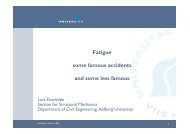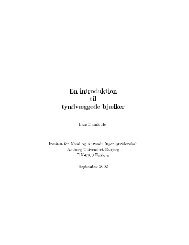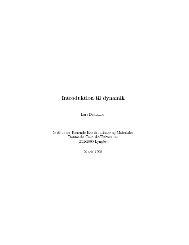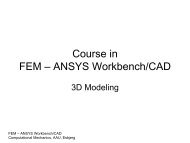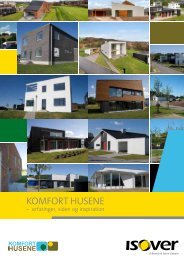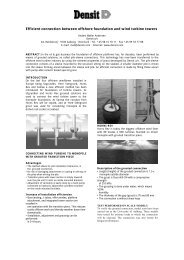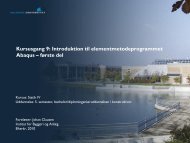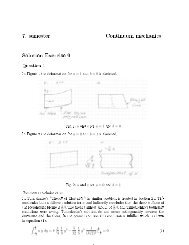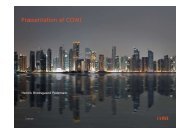Chapter 7 Summary and conclusions
Chapter 7 Summary and conclusions
Chapter 7 Summary and conclusions
- No tags were found...
You also want an ePaper? Increase the reach of your titles
YUMPU automatically turns print PDFs into web optimized ePapers that Google loves.
CHAPTER 7 SUMMARY AND CONCLUSIONSdependency on the Smagorinsky constant was large. But the need for special wall treatment in order toaccount for the reduction of subgrid scale lengths near the solid walls making this methods unfavourable,although it is simple to implement <strong>and</strong> very fast to compute. The dynamic model on the other h<strong>and</strong> gaveresults in good agreement with measurements. But the original dynamic model also needed a specialtreatment depending on whether the flow has one or more homogeneous direction(s) in which theequations could be averaged. For fully inhomogeneous flows only an averaging procedure in time isapplicable. To overcome the need for special treatment, the mixed scale model <strong>and</strong> a dynamic oneequationsubgrid model were also tested. The mixed scale model which was only tested by implementingit in the CFX software gave better results that the Smagorinsky model, but was not compatible with thedynamic subgrid models. The overall performance of the dynamic one-equation subgrid model did givebetter results than the other subgrid models, but were relatively expensive in terms of the computationalcosts, due to the fact that one more equation for the kinetic energy had to be solved, although the originaldynamic model requires some spatial averaging to obtain numerical stability.As for the two-equation turbulence model, like the st<strong>and</strong>ard k-I model which has been knownfor more than twenty years, it was found adequate for the full turbulent ventilation problems in thisproject. These kind of models will properly remain the most used models for the next decades.Nevertheless, its limitations are also well-known, particularly in flows where anisotropy is significant orin transitional flows. Several researchers have proposed modifications to this model, like anisotropicgeneralizations, or special treatment for low-Reynolds flows. An example is the k-I model arising fromthe renormalization group (RNG) theory. A high-strain correction, which is not strictly a result of theRNG analysis, to the I-equation is made so as to increase the dissipation rate <strong>and</strong> thus diminishingturbulent length scales. In separated flows, this leads to a relatively large recirculation zone as comparedto the st<strong>and</strong>ard k-I model. Unlike the k-I variants, the Wilcox k-q model can indeed be used across theviscous sublayer without low-Reynolds-number dependence. A qualified guess would be that due to thedevelopment <strong>and</strong> use of LES <strong>and</strong> DNS, the two-equations models will become more realisable forcomplex flows. But for transition problems <strong>and</strong>/or time dependent situations, LES will probably be thebest choice. But since LES is a relatively new tool compared to the two-equations models, some lessonshave to be learned, like better treatment of boundary conditions, <strong>and</strong> how advanced the subgrid scalemodels should be to capture important flow features.Finally, the need for a fast numerical solver <strong>and</strong> better implementation in order to improve thecomputational performance <strong>and</strong> efficiency when applying Large Eddy Simulation to a problem isemphasize. The explicit <strong>and</strong> implicit implementation was at last compared in terms of computationalefficiency (Elapsed Wall Clock Time). The implicit method did shown superior over the explicit method,due to the possibility of using larger time steps. It was however not investigated if the implicit methodwould retain superiority in the simulation of transitional flows. The dem<strong>and</strong> for a very fast method forthe solution of the Pressure Poisson equation were shown while comparing different preconditioningmethods for the Conjugate Gradient iterative solver <strong>and</strong> a multigrid implementation. The ConjugateGradient with Matrix-Renumbering Incomplete LU preconditioning <strong>and</strong> the multigrid implementationdid show almost grid-independent convergence rate.186
CHAPTER 7 SUMMARY AND CONCLUSIONSIn general, the numerical simulation of turbulence is an extremely intensive computational task<strong>and</strong> quickly saturates even the impressive gains in computer speed that marks every new development incomputer technology. This fact, coupled with the extraordinary theoretical difficulties involves indeveloping any statistical closure theory of turbulence propels Large Eddy Simulation as one of the mostversatile tools for the calculations of complex flows . Or the combination of traditional ReynoldsAveraging Simulation with Large Eddy Simulation, known as Detached Eddy Simulation.The use of high performance computer systems will make the Large Eddy Simulation methodmore attractive. Especially, the use of latest processor technology <strong>and</strong> the use of parallel computers. Mostof the simulation within this project was done of a PC-workstation, which is currently one year behindthe latest processor technology. Upgrading would reduce the computational time by almost a factor oftwo using PC technology <strong>and</strong> almost a factor of four when using UNIX workstation with the Alphaprocessor.The potential for Large Eddy Simulation for visualization of essential flow structures in the flowas well as for reliable quantitative predictions has been demonstrated, at least for relatively simplegeometries. One of the challenges ahead would be to demonstrate unambiguously that Large EddySimulation is able to predict quantitatively statistical measures of interest in the domain of truly complexengineering flows.7.2 Directions of future work.Beside the general cleanup <strong>and</strong> a small part of recoding, there are different paths to follow. Onewould be the extention of the code to be able to simulate the effect of dispersions of particles <strong>and</strong> gaseouspollutants in similar ventilated enclosures, since in general the building geometries that we are interestedin are rectangular. Another path would be the more advanced models for the simulation of non-isothermalconditions that would also be an important issue of the code. Last but not least the code needs to beextented with multi-block facilities. Which will enable more complex geometries to be simulated. Sincethe Large Eddy Simulation methods are very computing intensive, this subject was postponed to later.An extension to use parallel computer systems to further reduce the massive cpu-time consumption willbe need.One final word about parallel computing should be said: since the dem<strong>and</strong>s especially when usingLES are so high, the field of high performance computing should be studied further <strong>and</strong> in particular thatof parallel computing. The field of high performance computing is very relevant to turbulence flowsimulation in general. Even with the vector super computer available at present much remains to be done.Programming to achieve high performance on vector supercomputer <strong>and</strong> serial computer (RISC CPU) isquite different as illustrated in this project. The different architectures of these computer systems, requirethe adaptation of different implementations of existing algorithms, even such basic methods as the BLAS.Moreover, there is a great need for efficient algorithms based on parallel computing to realize the highcomputing speeds needed in the future. The aspects of communication between several processors in aparallel computer <strong>and</strong> the minimation of the associated overhead are worth further research. This is very187
CHAPTER 7 SUMMARY AND CONCLUSIONSevident with the development of the Beowolf 1 like computer systems. The Beowulf parallel workstationproject is driven by a set of requirements for high performance scientific workstations in the Earth <strong>and</strong>space science communities <strong>and</strong> the opportunity of low cost computing made available through the PCrelated mass market of commodity subsystems. This opportunity is also facilitated by the availability ofthe Linux operating system, a robust Unix-like system environment with source codes that are targetedfor the Intel x86 family of microprocessors including the Intel Pentium.An important key component to forward compatibility is the system software used on Beowulf. With thematurity <strong>and</strong> robustness of Linux, GNU software <strong>and</strong> the "st<strong>and</strong>ardization" of message passing via PVM<strong>and</strong> MPI, programmers now have a guarantee that the programs they write will run on future Beowulfclusters, regardless of who makes the processors or the networks. A natural consequence of coupling thesystem software with vendor hardware is that the system software must be developed <strong>and</strong> refined onlyslightly ahead of the application software. The criticism that system software for high performancecomputers is always inadequate is actually unfair to those developing it. In most cases coupling vendorsoftware <strong>and</strong> hardware forces the system software to be perpetually immature. The model used forBeowulf system software can break that rule.Beyond the seasoned parallel programs, Beowulf clusters have been built <strong>and</strong> used by programmers withlittle or no parallel programming experience. In fact, Beowulf clusters provide universities, often withlimited resources, an excellent platform to teach parallel programming courses <strong>and</strong> provide cost effectivecomputing to their computational scientists as well. The startup cost in a university situation is minimalfor the usual reasons: most students interested in such a project are likely to be running Linux on theirown computers, setting up a lab <strong>and</strong> learning to write parallel programs is part of the learning experience.1 ) More information about the Beowolf system at the Internet homepage:http://www.beowulf.org/188
ReferencesAgarwal, R.K.: ‘ A third-order-accurate upwind scheme for Navier-Stokes solution at high Reynoldsnumbers’, AIAA Paper no. 81-0112, 1981.Akselvoll, K. <strong>and</strong> Moin, P., ‘Large Eddy Simulation of turbulent confined co-annular jets <strong>and</strong> turbulentflow over a backward facing step. Technical Report TF-63, Stanford University, Dept. of MechanicalEngineering (1995).Akselvoll, K. <strong>and</strong> Moin, P.: ‘Large eddy simulation of a backward facing step flow’, In W. Rodi <strong>and</strong> M.Martelli (Eds.), 2nd International Symposium on Engineering Turbulence Modelling <strong>and</strong> Measurements,NewYork. Elsevier Science., 1993Antonopoulos-Domis, M.: ‘Aspects of large eddy simulation of homogeneous isotropic turbulence’, Int.J. Numerical Methods in Fluids 1, 273-290, 1981.Armaly, B.F., Durst, F,. Pereira, J.C.F. <strong>and</strong> Schoenung, B.: ’Experimental <strong>and</strong> Theoreticalinvestigation of Backward-facing step flow’, J. of Fluid Mech., Vol. 127, pp. 473-496, 1983.Arpaci V.S. <strong>and</strong> Larsen P.S.: ‘Convection Heat transfer’, Prentice-Hall Inc. 1984.Baldwin, B. S. <strong>and</strong> Lomax, H: ‘Thin-layer approximation <strong>and</strong> algebraic models for separated turbulentflows’, AIAA Paper, 78-257, Huntsville, AL, 1978.Bardina, J., Ferziger, J. H., <strong>and</strong> Reynolds, W. C. :‘Improved turbulence models based on large eddysimulation of homogeneous, incompressible, turbulent flows’, Report No. TF-19, Mechanical EngineeringDepartment, Stanford University, Stanford, California., 1983.Barrett R., Berry, M., Chan T. F., Demmel J.,Donato J.,Dongarra J., Eijkhout V., Pozo R., RomineC. <strong>and</strong> Van der Vorst, H.:’ Templates for the Solution of Linear Systems: Building Blocks for IterativeMethods’, SIAM Philadelphia, 1994.Baum, H. R.; McGrattan, K. B.; Rehm, R. G. : ‘Large Eddy Simulation of Smoke Movement in ThreeDimensions’, Interscience Communications Ltd.; National Institute of St<strong>and</strong>ards <strong>and</strong> Technology;Building Research Establishment; <strong>and</strong> Society of Fire Protection Engineers; Swedish National Testing<strong>and</strong> Research Institute. Interflam '96. International Interflam Conference, 7th Proceedings. March 26-28,1996, Cambridge, Engl<strong>and</strong>, Interscience Communications Ltd., London,Engl<strong>and</strong>, Franks, C. A.; Grayson,S., Editors, 189-198 pp, 1996 AND U.S./Japan Government Cooperative Program on Natural Resources(UJNR). Fire Research <strong>and</strong> Safety. 13th Joint Panel Meeting. Volume 1. NISTIR 6030. March 13-20,1996, Gaithersburg, MD, Beall, K. A., Editor, 249-258 pp, 1997, 1996.(Available at: http://flame.cfr.nist.gov/bfrlpubs/bfrl97/auth/auth269.html )189
REFERENCESBennetsen, J.C.: ‘The Computational Fluid Dynamics code Solver: User Guide <strong>and</strong> the NumericalImplementation’, Internal Report, Danish Institute of Agricultural Sciences, Dept. of AgriculturalEngineering, Research Centre Bygholm, Denmark, (In preparation), 2001.Bennetsen, J.C. (A): ‘Large Eddy Simulation of Three-Dimensional Airflow inside a Ventilated TestRoom’, (Submitted), The 7 th International Conference on Air Distributions in Rooms, RoomVent 2000,Reading, United Kingdom, 2000.Bennetsen, J.C. (B): ‘Studying Air Flow in open type building with transitional turbulence models <strong>and</strong>Large Eddy Simulation’, (Submitted), The 7 th International Conference on Air Distributions in Rooms,RoomVent 2000, Reading, United Kingdom, 2000.Bennetsen, J.C. (C): ‘Beyond RANS, Large Eddy Simulation in Transitional Flows - Status, CurrentTrends <strong>and</strong> Observations on test cases’, (Submitted), The 7 th International Conference on AirDistributions in Rooms, RoomVent 2000, Reading, United Kingdom, 2000.Bennetsen, J.C., Sørensen, J.N, Søgaard, H.T., Christansen, P.L.,’Numerical Simulation ofTurbulent air flow in a Livestock Building', 5th International Conference on Air Distribution in Rooms,ROOMVENT '96, Ed. S.Murakami, Vol.2, pp.169-176, Yokohama, Japan, July 1996.Blay D., Mergui S., Niculae C.:, ‘Confined turbulent mixed convection in the presence of a horizontalbuoyant wall jet. Fundamentals of mixed convection, HTD 213: pp. 65-72, 1992Boon C.R.: ‘The effect of air speed changes on the group postural behavior of pigs.’ Journal ofAgricultural Engineering Research, 27(1), pp.71-79, 1982.Botta, E.F.F <strong>and</strong> Wubs F.W.: ’MRILU: an effective algebraic multi-level ILU-preconditioner for sparsematrices’, SIAM, J. Matrix Anal. Appl. (To appear), 1999.Boussinesq, J: ‘Essai sur la theorie des eaux courantes.’ Mem Presentes Acad. Sci, p. 23-46 Paris, 1877.Breuer, M.: ‘Flow Around Surface-Mounted Cubical Obstacle -- Description of the LES Method <strong>and</strong>Simulations’, Proc. of the 6th ERCOFTAC/IAHR/COST Workshop on Refined Flow Modelling, eds. K.Hanjalic <strong>and</strong> S. Obi, Delft University of Technology, June 6-7, 1997.Breuer, M.: ‘Large Eddy Simulation of the Sub Critical Flow Past a Circular Cylinder: Numerical <strong>and</strong>Modeling Aspects’, Int. J. for Numerical Methods in Fluids, vol. 28, pp. 1281-1302, 1998Breuer, M. <strong>and</strong> Pourquie, M.: ‘First Experiences with LES of Flows past Bluff Bodies’, Proc. of the3rd Intern. Symposium of Engineering Turbulence Modelling <strong>and</strong> Measurements, Heraklion-Crete,Greece, May 27-29, 1996, Engineering Turbulence Modelling <strong>and</strong> Experiments 3, pp. 177-186,W. Rodi <strong>and</strong> G. Bergeles (eds.), Elsevier Science B.V., 1996.190
REFERENCESBreuer, M., Lakehal, D., Rodi, W.: ‘Flow around a Surface Mounted Cubical Obstacle: Comparisonof LES <strong>and</strong> RANS-Results’, IMACS-COST Conference on Computational Fluid Dynamics, Three-Dimensional Complex Flows, Lausanne, Switzerl<strong>and</strong>, Sept. 13-15, (1995), In: 'Computation of 3DComplex Flows', eds. M. Deville, S. Gavrilakis <strong>and</strong> I.L. Rhyming, Notes on Numerical Fluid Mechanics,vol. 53, pp. 22-30, Vieweg Verlag, Braunschweig, 1996.Bækbo P.: ‘Air quality <strong>and</strong> Health in swine farms’, Ph.D.-Thesis in danish, The Royal Veterinary <strong>and</strong>Agricultural University, Copenhagen, 1989.Cabot, W. <strong>and</strong> Moin, P. :‘Large eddy simulation of scalar transport with the dynamic subgrid-scalemodel’,. In B. Galperin <strong>and</strong> S. A. Orszag (Eds.), Large Eddy Simulation of Complex Engineering <strong>and</strong>Geophysical Flows, New York. Cambridge University Press. 1993.Cebeci, T <strong>and</strong> Smith, A. M. O.: ‘Analysis of turbulent boundary layers’, Ser. In Appl. Math & Meth,XV, Academic Press, 1974Chien, K.–Y. :’Predictions of Channel <strong>and</strong> Boundary–Layer Flows with a Low–Reynolds NumberTurbulence Model’, AIAA J., Vol. 20, pp 33–38, 1982.CFX-Solver manual, Version 4.2 Harwell Laboratory, Oxfordshire OX11 ORA, Engl<strong>and</strong>, CFDS-Computational Fluid Dynamics Services, 1997Chen, H.C. <strong>and</strong> Patel V.C.: ‘Near-Wall Turbulence Models for complex flows including separation’,AIAA J., Vol .26, pp. 641-648, 1988.Chen, Q.: ‘Computational fluid dynamics for HVAC: successes <strong>and</strong> failures’ , ASHRAE Transactions,103(1), pp. 178-187, 1997.Chen, Q.: ‘Prediction of room air motion by Reynolds-stress models’, Building <strong>and</strong> Environment, 31(3),pp.233-244, 1996.Chen, Q.: ‘Comparison of different k-e models for indoor airflow computations’, Numerical HeatTransfer, Part B: Fundamentals, 28, 353-369, 1995 (a).Chen, Q., Peng, X. <strong>and</strong> Paassen, A.H.C. van.: ‘Prediction of room thermal response by CFD techniquewith conjugate heat transfer <strong>and</strong> radiation models’, ASHRAE Transactions, 101(2),pp.50-60. 1995 (b).Chol, H. <strong>and</strong> Moin, P. : ’Effects of the computational time step on numerical solutions of turbulent flow’J. of Comput. Physics, 113(1) pp. 1-4, 1994.Chollet, J.-P., Voke, P.R. <strong>and</strong> Kleiser, L., eds.: ‘Direct <strong>and</strong> Large-Eddy Simulation II: Proceedings ofthe Second ERCOFTAC Workshop, Kluwer Academic, Dordrecht (1997).191
REFERENCESClark, R. A., Ferziger, J. H., <strong>and</strong> Reynolds, W. C.: ‘Evaluation of subgrid-scale models using anaccurately simulated turbulent flow’, Journal of Fluid Mechanics 91, 1-16., 1979.Craft, T.J., Launder, B.E., <strong>and</strong> Suga, K.: ‘Extending the applicability of eddy viscosity models thoughthe use of deformation invariant <strong>and</strong> non-linear elements’, In Proc. 5 th Int. IAHR Symp. On Refined FlowModelling <strong>and</strong> Turbulence Measurements, pp. 125-132, Presses Ponts et Chaussées, Paris, 1993.Cziesla,T., Braun,H , Biswas G., <strong>and</strong> Mitra, N.K.: ‘Large Eddy Simulation in a channel with exitboundary condition’, NASA CR-198304 ICASE Report No. 96-18, Institute for Computer Applicationsin Science <strong>and</strong> Engineering Mail Stop 132C, NASA Langley Research Centre Hampton, VA 23681-0001,March 1996, pp. 21.Davidson, L. <strong>and</strong> Farhanieh, B., ‘CALC-BFC: A Finite-Volume Code Employing CollocatedVariable Arrangement <strong>and</strong> Cartesian Velocity Components for Computation of Fluid Flow <strong>and</strong> HeatTransfer in Complex Three-Dimensional Geometries’, Rept. 92/4, Thermo <strong>and</strong> FluidDynamics, Chalmers University of Technology, Göteborg, 1992.Davidson, L.: ‘Large Eddy Simulation: A Dynamic One-Equation Subgrid Model for Three-DimensionalRecirculating Flow’, 11th Int. Symp. on Turbulent Shear Flow, Vol. 3, pp.26.1- 26.6, Grenoble, Sept. 8-11, 1997. (Available at: http://www.tfd.chalmers.se/~lada )Davidson, L. <strong>and</strong> Nielsen, P.: ‘Study of Low-Reynolds Number Effects in Backward-Facing Step FlowUsing Large Eddy Simulations’, 6th Int. Conf. on Air Distributions in Rooms, ROOMVENT'98, Eds: E.Mundt & T.G. Malmström Vol. 1, pp. 125-132, Stockholm, Sweden, July 1998.(Available at: http://www.tfd.chalmers.se/~lada )Davidson, L. <strong>and</strong> Nielsen, P.: ‘A Study of Laminar Backward-Facing Step Flow’,Report, Dept. of Building Technology <strong>and</strong> Structural Engineering, Aalborg University, 1998.(Available at: http://www.tfd.chalmers.se/~lada )Davidson, L.: ‘LES of Recirculating Flow Without Any Homogeneous Direction: A DynamicOne-Equation Subgrid Model’, 2nd Int. Symposium on Turbulence Heat <strong>and</strong> Mass Transfer , pp.481-490 K. Hanjalic, T.W.J. Peeters (Editors) Delft University Press, 1997.(Available at: http://www.tfd.chalmers.se/~lada )Davidson, L. <strong>and</strong> Nielsen, P.: ‘Large Eddy Simulations of the Flow in a Three-Dimensional VentilatedRoom", 5th Int. Conf. on Air Distributions in Rooms, ROOMVENT'96, Ed: S. Murakami, Vol. 2, pp.161-168, Yokohama, Japan, July 1996. (Available at: http://www.tfd.chalmers.se/~lada )Davidson, L.: ‘Implementation of a Large Eddy Simulation Method Applied to Recirculating Flow ina Ventilated Room’, Rept. ISSN 1395-7953 R9611, Dep. of Building Technology <strong>and</strong> StructuralEngineering, Aalborg University, 1996. (Available at: http://www.tfd.chalmers.se/~lada )192
REFERENCESDavidson, L.: ‘Large Eddy Simulations: A Note on Derivation of the Equations for the Subgrid TurbulentKinetic Energies’, Rept. 97/12, Thermo <strong>and</strong> Fluid Dynamics, Chalmers University of Technology,Gothenburg, 1997. (Available at: http://www.tfd.chalmers.se/~lada )Davidson, L.: ’Numerical Simulation of Turbulent Flow in Ventilated Rooms, Ph.D. Thesis, ChalmersUniversity of Technology, Sweden, 1989.Deardorff, J. W. ‘A numerical study of three-dimensional turbulent channel flow at large Reynoldsnumber’, Journal of Fluid Mechanics 41, pp. 453-480., 1970Deardorff, J. W. (1973). The use of subgrid transport equations in a three-dimensional model ofatmospheric turbulence. Journal of Fluids Engineering 95, pp. 429-438, 1973.Dowed, Kevin: ‘High Performance Computing: RISC Architectures, Optimization <strong>and</strong> Benhcmarks’O’Reilly & Associates, Inc. 103 Morris Street, Suite A, Sebastopol, CA 95472. ISBN: 1-56592-032-5.Dubois, T, Jauberteau F., <strong>and</strong> Zhou,Y.: ‘Influences of subgrid scale dynamics on resolvable scalestatistics in large-eddy simulations’, NASA CR-198278 ICASE Report No. 96-7, Institute for ComputerApplications in Science <strong>and</strong> Engineering Mail Stop 132C, NASA Langley Research Center Hampton, VA23681-0001, February 1996, pp. 28.Durst, F. & Tropea, C.: ‘Turbulent, backward-facing step ows in two-dimensional ducts <strong>and</strong>channels’. In Proc. Third Intl Symp. on Turbulent Shear Flows, University of California, Davis,pp. 18.1-18.5., 1981El-Hady, N. M., Zang, T. A., <strong>and</strong> Piomelli, U. : ‘Application of the dynamic subgrid-scale model toaxisymmetric transitional boundary layer at high speed’,. Physics of Fluids. A 6 (3), 1299-1309., 1994Emmerich, S. <strong>and</strong> McGrattan K.:’Application of a large eddy simulation model to study room airflow,ASHRAE TRANSACTIONS, 104 (1), 1998.Emmerich, S. ’Use of Computational Fluid Dynamics to analyze Indoor Air Quality Issues’,Internal report, Building <strong>and</strong> Fire Research Laboratory, Gaithersburg MD 20899,National Institute of St<strong>and</strong>ards <strong>and</strong> Technology, United States Department of Commerce TechnologyAdministratio, Report nr. NISTIR 5997, 1997.Emvin, P.:’The Full Multigrid Method Applied to Turbulent Flow in Ventilated Enclosures UsingStructured <strong>and</strong> Unstructured Grids", PhD thesis, Dept. of Thermo <strong>and</strong> Fluid Dynamics, Chalmers Univ.ofTech., Göteborg, 1997.Flectcher, C.A.J.: ‘Computational Techniques for Fluid Dynamics’, Vol. I & II, second editionSpringer Verlag, Berlin, 1991, ISBN 0-387-52601-9193
REFERENCESFerziger, J.H. <strong>and</strong> Peri¡ M.: ‘Computational Methods for Fluid Dynamics’, Springer Verlag,ISBN Number: 3-540-59434-5, 1996Franke R., <strong>and</strong> Rodi, W. : ’Calculation of vortex shedding past a square cylinder with variousturbulence models’, in Proc. 8 th Symp. On Turbulent shear flows, p. 189, 1991.Freitas, C.J.: ‘Perspective: Selected Benchmark from commercial CFD codes’, Transactions of theASME, Vol. 117, pp. 208-218, June 1995.Germano, M.: ‘Turbulence: the filtering approach’, Journal of Fluid Mechanics 238, 325-336, 1992Germano, M., Piomelli, U., Moin, P., <strong>and</strong> Cabot, W. H. ‘A dynamic subgrid-scale eddy viscositymodel’,. Physics of Fluids. A 3 (7), 1760{1765, 1991.Ghia, U., Ghia, K.N., <strong>and</strong> Shin, C.T.: ‘High-Re solutions for incompressible flow using the Naiver-Stokes equations <strong>and</strong> a multigrid method’, J. Computational Physics, 48, p.387-411, 1982.Ghia, K.N., Osswald, G.A. <strong>and</strong> Ghia, U.: ‘Analysis of incompressible massively separated viscousflows using unsteady Navier-Stokes equations’, Int. J. Numerical Methods in Fluids, vol. 9, p. 1025, 1989.Ghosal, S., Lund,T.S. Moin P., <strong>and</strong> Akselvoll K.:.’A dynamic localization model for large-eddysimulation of turbulent flows’, Journal of Fluid Mechanics, vol. 286, pp. 229–255, 1995.Ghosal, S., Lund,T.S. Moin P., <strong>and</strong> Akselvoll K.:.. ‘Corrigendum’. Journal of Fluid Mechan-ics,vol 297, p.402, 1995.Gosman A.D., Nielsen P.V., Restivo, A. <strong>and</strong> Whitelaw, J.H.: ‘The flow properties in rooms with smallventilation openings’, Trans, ASME: Jornal of Fluid Engineering, vol. 102, pp. 316-323, 1980.Guj, G. <strong>and</strong> Stella, F. : ‘Numerical solutions of high Re recirculating flows in vorticity-velocity form’,Int. J. Numerical Methods in Fluids, vol. 8, p. 405, 1988.Hanjali¡, K.: ‘Advanced turbulence closure models: a view of current status <strong>and</strong> future prospects’, Int.J. Heat Fluid Flow, 15: 178-203, 1994.Hanjalic, K., Kenjereš S. <strong>and</strong> Durst, F.: ‘Natural convection in partitioned two-dimensional enclosuresat higher Rayleigh numbers’, Int. J. Heat Mass Transfer 3 9, pp. 1407-1427, 1996.Henkes, R. A. W. M., Van Der Vlugt, F. F. <strong>and</strong> Hoogendoorn, F. F.: ‘Natural-convectionflow in a square cavity calculated with low-Reynolds-number turbulence models’, Int. J. Heat MassTransfer 34, 377-388, 1991.194
REFERENCESHinze, J.O.:’Turbulence’, McGraw-Hill, New York, Second Edition, 1975.Hirt, C.W. <strong>and</strong> Cook, J.L.: Calculating three-dimensional flows around structures <strong>and</strong> over roughterrain. J. Computational Physics, 10, p. 324-340 (1972).Hjort C.: ‘Respiratory problems in agriculture’, Presented at the seminar: Working environment <strong>and</strong> dustproblems in piggeries’, (in Danish). Danske Slagterier, Denmark, 1990.Horiuti, K.: ‘Large eddy simulation of turbulent channel flow by one-equation modelling’,. Journal ofthe Physical Society of Japan 54 (8), p.2855-2865, 1985.Hortmann,M. Peric, M., Scheurer G.: ‘ Finite volume multigrid prediction of laminar naturalconvection: bench-mark solutions’, Int. J. Numerical Methods Fluid, 11, pp.187-207, 1990IEA.: ‘Air flow pattern within buildings’, Flow Flash, no.1, Int. Energy Agency, Annex 20.Ikohagi, T. <strong>and</strong> Shin, T.B.: ‘Finite-Difference schemes for steady incompressible Navier-Stokesequations in general coordinate’, Computers <strong>and</strong> Fluids, vol. 19 (3/4), p.479, 1991.Issa, R.I.: ‘Solution of the implicit discretized fluid flow equations by operator-splitting’, J.Computational Phys., Vo. 62, pp. 40-65.Issa, R.I., Gosman, A.D. <strong>and</strong> Wathin, A.P.: ‘The computational of compressible <strong>and</strong> incompressiblerecirculating flows’, J. Computational Phys., Vol. 62, pp. 66-82, 1986.Iversen M., Dahl R., Korsgaards J., Hallas T., Jensen E.J.:’Respiratory symptoms in Danish farmers:an epidemiological study of risk factors’, Thorax, 1988;Vol. 43, pp.872-877.Iversen M., Dahl R., Jensen E.J., Korsgaards J., Hallas T.:’Lung functions <strong>and</strong> bronchial reactivityin farmers’, Thorax, 1989;Vol. 44, (reprint).Jacobsen, C. B.: ’Large Eddy Simulation of Confined Swirling Flow; A numerical <strong>and</strong> experimentalinvestigation of isothermal combustion chamber flows’, Institute of Energy Technology, AalborgUniversity, May, 1997. ISBN: 87-89179-18-8.Jacobsen T. V.: ‘Airflow <strong>and</strong> Temperature Distribution in Rooms with Displacement Ventilation’,Ph.D.-Thesis, Dept. of Building Technology <strong>and</strong> Structural Engineering, Aalborg University, Denmark,1993.Jiang, B-N, Hou, L-J, <strong>and</strong> Lin, T-L: ’Least-square finite element solution for three-dimensionalbackward-facing step flow’, NASA TM 106353, 1993.195
REFERENCESJohansson, P.: ‘Numerical Simulations of Three-Dimensional Ventilated Enclosures Using a FullMultigrid Method’, Rept. 94/4, thesis of Lic. of Engng., Dept. of Thermo <strong>and</strong> Fluid Dynamics, ChalmersUniversity of Technology, Göteborg, 1994.Jones, W.P. <strong>and</strong> Launder, B.E. :“The Prediction of Laminarization with a Two–Equation Model ofTurbulence”, Int. J. Heat Transfer, Vol. 15, pp 301–314, 1972.Joslin, R.D.: ‘Discussion of DNS: Past, Present, <strong>and</strong> Future’ , First International Conference on DirectNumerical Simulation <strong>and</strong> Large Eddy Simulation (DNS/LES), Ruston, Louisiana, August 4-8, 1997,included in the Proceedings.Keyes, D.E., Kaushik, D.K. <strong>and</strong> Smith, B.F.:, ‘Prospects for CFD on Petaflops Systems’, in CFDReview, M. Hafez et. al., eds., Wiley. 1997Kim, J. <strong>and</strong> Moin, P. :‘Transport of passive scalars in a turbulent channel flow.’, In J.-C. Andre etal.(Eds.), Turbulent Shear Flows 6, Berlin, Springer-Verlag, pp. 85-96, 1989.Kim, J. <strong>and</strong> Moin, P.: ‘Application of Fractional step method to incompressible Navier-Stokesequations’, J. Comp. Physics, vol. 59, pp. 308-323. 19XXKline, Ferziger J. <strong>and</strong> Johnson P. :’Calculation of turbulent shear flows: Status <strong>and</strong> ten year outlook’,J. Fluid Engineering, 1978, vol. 100, p. 3.Krajnovic, S.: ’Large-Eddy Simulation of the Flow Around a Surface-Mounted Single Cube in aChannel", Master thesis, Rept. 98/7, Thermo <strong>and</strong> Fluid Dynamics, Chalmers University of Technology,Gothenburg, 1998. Available at: http://www.tfd.chalmers.se/~ladaKu, H.C., Hirsh, R.S., Taylor, T.D. <strong>and</strong> Rosenburg, A.P.: ‘A pseudospectral matrix element methodfor solution of three-dimensional incompressible flows <strong>and</strong> its parallel implementation, J. ComputationalPhysics, vol. 83, p. 260, 1989Kuehn, D. M. ‘Some effects of adverse pressure gradient on the incompressible reattachingover a rearward-facing step’. AIAA J. 18, 343-344, 1980.Launder, B.E.: ‘Second-Moment Closures: Present,.. <strong>and</strong> Future ?’, Int. J. Heat <strong>and</strong> Fluid Flow, 10,p. 283-300, 1989.Launder, B.E. <strong>and</strong> Spalding, D.B: ‘The numerical computational of turbulent flows’, Comp. Meth.Appl. Mech. Engineering, 3: 269-289, 1974.Launder, B.E. <strong>and</strong> Sharma, B.T.: ‘Application of the energy dissipation model of turbulence to thecalculation of flow near a spinning disc’, Letter in Heat <strong>and</strong> Mass Transfer, 1:131-138, 1974.196
REFERENCESLe, H. <strong>and</strong> Moin, P.: ‘Direct numerical simulation of turbulent flow over a backward-facing step’Technical Report TF-58, Stanford University, Dept. of Mechanical Engineering (1994).Le. H., Moin P. <strong>and</strong> Kim, J.: ‘ Direct numerical simulation of turbulent flow over a backwardfacingstep’, J. Fluid Mech. , 330, p. 349-374, (1997)Leonard B.P. ‘A Stable <strong>and</strong> Accurate Convective Modelling Procedure Based on Quadratic UpstreamInterpolation’, Comp. Meth. in Applied Mechanics <strong>and</strong> Engineering, Vol. 19, pp. 59-98, 1979.Leonard, A. ‘Energy cascade in LES of turbulent fluid flows’, In Adv. in Geophysics, Vol. 18.Leschziner M.A: ‘Modelling Engineering flows with Reynolds Stress turbulence closures’,J. Wind Engineering <strong>and</strong> Ind. Aerodyn., 35, p. 21-47, 1990.Lilly, D.K. ‘A proposed modification of the Germano subgrid-scale closure method’, Phys. FluidsA, vol. 4, pp. 633-635, 1992.Liu Q., Hoff S.J., Maxwell G.M. <strong>and</strong> Bundy D.S.: ‘Comparison of three k-I turbulence models forpredicting ventilation air jets’, Transactions of the ASAE, 39(2), p. 689-698, 1996Liu, C. <strong>and</strong> Liu, Z. (editors): ‘Advances in DNS/LES’, The FIRST AFOSR INTERNATIONALCONFERENCE ON DNS/LES (FAICDL), sponsored by the US Air Force Office of Scientific Research(AFOSR), will be hosted by Louisiana Tech University, Ruston, Louisiana, USA on August 4-8, 1997.Published by Greyden Press.Llorente, I.M. <strong>and</strong> Melson, N.D.:’ Robust Multigrid Smoothers for three Dimensional Elliptic Equationswith strong anisotropies’, ICASE Report 98-37, 1998, NASA, Langley Research Centre , Hampton,Virginia, 23681-2199, USA.Lyn, D.A., Einav, S., Rodi, W. <strong>and</strong> Park, J.H.:’A laser-Doppler velocimetry study of ensembleaveragedcharacteristics of the turbulent near wake of a square cylinder’, J. Fluid Mech., 304, 285-3191995.Lyn, D.A., <strong>and</strong> Rodi, W. :’The Flapping shear layer formed by flow separation from the forward cornerof a square cylinder’, J. Fluid Mech., vol 267, pp. 353-376, 1994.McGrattan, K. B.; Baum, H. R.; Rehm, R. G. : ‘Large Eddy Simulation of Smoke MovementFire Safety Journal, Vol. 30, No. 2, 161-178, March 1998.(Available at: http://flame.cfr.nist.gov/bfrlpubs/bfrl97/auth/auth269.html )Meyer, K.E.: ‘Experimental <strong>and</strong> Numerical investigation of turbulent flow <strong>and</strong> heat transfer in staggeredtube bundles’, Ph.D-thesis, Dept. of Fluid Mechanics, The Technical University of Denmark, Denmark.AFM-94-03, Januar 1994. ISSN: 0590-8809.197
REFERENCESMoin, P., Squires, K., Cabot, W., <strong>and</strong> Lee, S.:‘A dynamic subgrid-scale model for compressibleturbulence <strong>and</strong> scalar transport’. CTR Manuscript 124, Centre for Turbulence Research, StanfordUniversity, Stanford, California., 1991.Moin, P. <strong>and</strong> Jimenéz, J.: ‘Large eddy simulation of complex turbulent flows’, AIAA paper 93-3099,1993Mochida A., Murakami S., Shoji M., Ishida Y.: ‘Numerical Simulation of Flow Field around TexasTech Building by Large Eddy Simulation’ Journal of Wind Engineering <strong>and</strong> Industrial Aerodynamics,46 <strong>and</strong> 47, p. 455-460, 1993.Murakami S.,Mochida A. <strong>and</strong> Hibi K.: ‘Three-Dimensional numerical simulation of airflow arounda cubic model by means of large eddy simulation’, Journal of Wind Engineering <strong>and</strong> IndustrialAerodynamics, 25, p 291-305, 1987.Murakami, S., Kato S., Chikamoto T., Laurence D., <strong>and</strong> Blay, D.:‘New low-Reynolds number k-emodel including damping effect due to buoyancy in a stratified flow field. Int. J. Heat Mass Transfer, vol39 (16), pp. 3483-3496., 1996Murakami S.,Mochida A. <strong>and</strong> Hayashi Y.: ‘Examining the k-I model by means of a wind tunnel test<strong>and</strong> Large-Eddy Simulation of the turbulence structure around a cube’, Journal of Wind Engineering <strong>and</strong>Industrial Aerodynamics, 35, p 87-100, 1990.Murakami, S.:’Current status <strong>and</strong> future trends in computational wind engineering’, J. Wind Engineering<strong>and</strong> Industrial Aerodynamics, 67&68, p.3-34, 1997.Najjar F.M. <strong>and</strong> Tafti, D.K.: ‘Study of Discrete Test Filters <strong>and</strong> Finite Difference Approximations forthe Dynamic Subgrid-Scale Model’, Physics of Fluids 8(4), April 1996.Najjar F. <strong>and</strong> Tafti D. K. ‘Comparison of Finite Difference Discretizations for High Reynolds NumberTurbulent Channel Flow with the Dynamic Subgrid-Scale Stress Model," Advances in DNS/LES,Proceedings of the First AFOSR International Conference on DNS/LES, pp. 539-546, Louisiana TechUniversity, Aug. 4-8, 1997.Nallasamy, M.: ‘Turbulence models <strong>and</strong> their applications to prediction of internal flows - a review’,Comput. Fluid, 15,151-194, 1987Nielsen, J.R.: ‘The influence of office furniture on the air movements in a mixing ventilated room’,Ph.D.-Thesis no. 10, Indoor Environmental Engineering, Aalborg University, Denmark, 1998, ISSN1395-7953 R9837.Nielsen, P.V.: ‘Airflow simulation technique - Progress <strong>and</strong> trends’, 10th AIVC conference proceedings,vol. 11, 1989 .198
REFERENCESNielsen, P. V.:’Specification of a two-dimensional test case’, Dept. of Building Technology <strong>and</strong>Structural Engineering, Aalborg University, Aalborg, 1990, ISSN: 0902-7513 R9040.Nielsen, P.V.: ‘Displacement ventilation: Theory <strong>and</strong> Design.’, Aalborg University, Aalborg,Denmark, 1993.Nielsen, P. V.: ‘Flow in Air Conditioned Rooms (English translation of Ph. D. thesis, TechnicalUniversity of Denmark, 1974), Danfoss, Denmark, 1976Nielsen, P. V., Restivo, A. <strong>and</strong> Whitelaw, J. H.: ‘The velocity characteristics of ventilated rooms,J. Fluids Engineering’, Transactions of ASME, 100: pp. 291-298, 1978.Nielsen, P. V. : ‘The selection of turbulence models for prediction of room airflow’, ASHRAETransactions, 104(1), 1998.Hilsson, H. <strong>and</strong> Davidson, L.: ‘Calc-LES: A Parallel SIMPLEC Multiblock Solver for Turbulent Flowin Complex Geometries’, Rept. 98/12, Thermo <strong>and</strong> Fluid Dynamics, Chalmers University of Technology,Gothenburg, 1997. (Available at: http://www.tfd.chalmers.se/~lada )Olsson M. <strong>and</strong> Fuchs L. : ‘ Siginificant Terms in the Dynamic Subgrid Scale Modelling’, FirstERCOFTAC Workshop on Large Eddy Simulation, Guildford, March, 1994 (in Voke, et al. 1994).Olsson, M. <strong>and</strong> Fuchs, L.: ‘Simulation of a co-annular swirling jet using a dynamic SGS-model’ AIAApaper 94-0654, 1994.Patankar, S.V.: ‘Numerical Heat Transfer <strong>and</strong> Fluid Flow’, Hemiphere Publising Corporation, Taylor& Francis Group, New York, 1980.Park T.S. <strong>and</strong> Sung H. J.: A nonlinear low-Reynolds-number k-I model for turbulent separated <strong>and</strong>reattaching flow - 1; Flow field computations ‘, Int. J. Heat Mass Transfer, vol. 38, no.14, pp.2657-2666.1995.Patankar, S.V. <strong>and</strong> Spalding D.B.: A calculation procedure for heat, mass <strong>and</strong> momentum transfer inthree-dimensional parabolic flow,Pauley, L. L., Moin, P. & Reynolds, W. C. ‘A numerical study of unsteady laminar boundarylayer separation’, Rep. TF-34. Thermo sciences Division, Dept. of Mech. Eng., StanfordUniversity, 1988Peeters, T. W. J. <strong>and</strong> Henkes, R. A. W. M., ‘The Reynolds-stress model of turbulence applied to thenatural-convection boundary layer along a heated vertical plate’, Int. J. Heat Mass Transfer 35, pp.403-420, 1992199
REFERENCESPeng, S.-H.: ‘Modelling of Turbulent flow <strong>and</strong> Heat Transfer Modelling for Building Ventilation",PhD thesis, Dept. of Thermo <strong>and</strong> Fluid Dynamics, Chalmers Univ. of Tech., Göteborg, 1998.Peng, S.-H.: ‘Evaluation of numerical simulation for ventilation flow’, Thesis for Licentiate ofEngineering, Division of Heating <strong>and</strong> Ventilation, Dept. of Energy Technology,Royal Institue of technology, Stockholm, Sweden, 1994.Peng, S.-H. <strong>and</strong> Davidson, L.: ‘Comparison of Subgrid-Scale Models in LES for Turbulent ConvectionFlow With Heat Transfer", 2nd Turbulent Heat Transfer, Vol. 1, pp. 5.25-5.35, Manchester, UK, 1998.Peng, S.-H., Davidson, L. <strong>and</strong> Holmberg, S. : ‘The Two-Equations Turbulence k-omega Model Appliedto Recirculating Ventilation Flows", Rept. 96/13, Thermo <strong>and</strong> Fluid Dynamics, Chalmers University ofTechnology, Göteborg, 1996.Available at http://www.tfd.chalmers.se/~ladaPeng, S.-H. <strong>and</strong> Davidson, L.: ‘A Proposed Subgrid-Scale Model in Large Eddy Simulation forTurbulent Thermal Convection Flow’, Thermo <strong>and</strong> Fluid Dynamics, Chalmers University of Technology,Gothenburg, 1997. Available at http://www.tfd.chalmers.se/~ladaPeng, S-H, Davidson, L. <strong>and</strong> Holmberg, S.: ’`Performance of Two-equation Turbulence Models forNumerical Simulation of Ventilation Flows'', 5th Int. Conf. on Air Distributions in Rooms,ROOMVENT'96, Ed: S. Murakami, Vol. 2, pp. 153-160, Yokohama, Japan, July 1996.Perzon, S.: ‘Reynolds Stress Modelling of Flow Separation on Curved Surfaces’, Lic. Thesis,Chalmers University of Technology, Dept. of Thermo <strong>and</strong> Fluid Dynamics, Sweden, 1997Piomelli, U.:’ Models for Large Eddy Simulations for turbulent channel flow including transpiration’Ph.D.-thesis, St<strong>and</strong>ford University, St<strong>and</strong>ford, California, 1988.Piomelli, U. : ‘Large-eddy simulation: present state <strong>and</strong> future directions’, AIAA Paper 98-0534, 1998.Piomelli U. <strong>and</strong> Liu J.: ‘Large Eddy Simulation of Rotating Channel Flows using a localizedDynamic Model’,.In AGARD (Advisory Group for Aerospace Research & Development) 74th FluidDynamics Panel on: Application of Direct <strong>and</strong> Large Eddy Simulation to transaction <strong>and</strong> Turbulence,Chania, Crete, Greece, the 18-21 April 1994.Piomelli, U. : ‘Large-eddy simulation: achievements <strong>and</strong> challenges. Progress in Aerospace Sciences35, pp. 335-362 (1999).Piomelli U. <strong>and</strong> Chasnov, J.R..: ‘Large-eddy simulations: theory <strong>and</strong> applications’. In Transition <strong>and</strong>turbulence modelling, edited by D. Henningson, M. Hallbaeck, H. Alfreddson <strong>and</strong> A. Johansson, (KluwerAcademic Publishers, Dordrecht), pp. 269-336, (1996).200
REFERENCESPiomelli, U. : ‘High Reynolds number calculations using the dynamic subgrid-scale stress model’,Physics of Fluids. A. 5 (6), 1484-1490. 1993.Piomelli, U., Cabot, W. H., Moin, P., <strong>and</strong> Lee, S.: ‘Subgrid-scale backscatter in turbulent <strong>and</strong>transitional flows’,. Physics of Fluids. A 3 (7), 1766-1771., 1991Pr<strong>and</strong>tl, L.: ‘Uber die ausgebildete turbulenz’, ZAMM, vol. 5, p. 136-139, 1925Ra, S. H. <strong>and</strong> Chang, P. K. ‘Effects of pressure gradient on reattaching flow downstream of arearward-facing step’, J. Aircraft 27, 93-95, 1990.Renard, J. <strong>and</strong> Gresser, D.:’Computational Modelling of 2D Hill Flows’, Rept. 95/6, Thermo <strong>and</strong> FluidDynamics, Chalmers University of Technology, Gothenburg, 1997. (Available at:http://www.tfd.chalmers.se/~lada ), 1995.Restivo, A. M. O.:’Turbulent Flow in Ventilated Rooms’, Ph. D. Thesis, Imperial College, Mech. Eng.Department, London.1979.Reynolds W.C.: ‘Computational of Turbulent Flows‘, Annual Review of Fluid Mechanic, vol. 8, pp. 183,1976.Rhie, C.M. <strong>and</strong> Chow, W.L.: ‘Numerical Study of Turbulent flow past an Airfoil with trailing EdgeSeparation’, AIAA J. , Vol. 2 pp. 1525-1532, 1983.Rodi, W. ‘Experience with Two–Layer Models combining the k–I Model with a One–Equation ModelNear the Wall’, AIAA Paper 91–0216, 1991Rodi, W.: ’ Turbulence models <strong>and</strong> their application in hydraulics - A state of the art review’,International Association of Hydraulic Research , Delft, The Netherl<strong>and</strong>s, 1984.Rodi, W.: ’On the simulation of turbulent flow past bluff bodies’, J. Wind Eng. Ind. Aerodyn.46/47, p. 3-19, 1993.Rodi, W., Ferziger, J., Breuer, M. <strong>and</strong> Pourquié, M.:, ‘Status of Large Eddy Simulation: Result ofa Workshop’, J. Fluid Eng., June 1996. (to appear).Rogallo, R. S. <strong>and</strong> Moin, P. ‘Numerical simulation of turbulent flows’, Annual Reviews of FluidMechanics vol. 16, p.99-137. 1984.Ruben, S.G. <strong>and</strong> Khosla, P.K. : ‘XX’J. Computational Physics, 9, p. 163, 1981.Rubenstein, R. <strong>and</strong> Barton, J.M.: ‘Non-linear Reynolds stress models <strong>and</strong> the re-normalisation group’,Phys. Fluids A, 2: 1472, 1990.201
REFERENCESRyl<strong>and</strong>er R., Donham K.J., Hjort C., Brouwer R., Heederik D.: ‘Effects of exposure to dust in swineconfinement buildings - a working group report’, Sc<strong>and</strong>. J. Work Environ. Health, Vol. 15pp.309-312. 1989.Saad, Y. :’Iterative Methods for Sparse Linear Systems’, PWS Publishing, New York, 1996Saad, Y. :’ ILUT: a dual threshold incomplete ILU preconditioner’, Numer. Linear Algebra Appl.,1 (4), p.387-402, 1994Saad, Y.: ‘Krylov Subspace Methods on Supercomputers’, SIAM, J. Sci. Stat. Comput. Vol. 10,no. 6, pp. 1200-1232, 1989.Sagaut, P.: ’Simulations numériques d’écoulements décolles avec dés modéles de sous-maille’,Ph.D-thesis, Université Paris VI, 1995Sagaut, P. <strong>and</strong> Loc, T.P.: ’Numerical Simulation with subgrid scale modeles for separated flow’,Presentation at IONES Seminar at the Technical University of Denmark, May 1994.Sagaut, P. ,Troff B., Lé T.H. <strong>and</strong> Loc, T.P.: ’Numerical Simulation with subgrid scale modelles forseparated flow’, First ERCOFTAC Workshop on Large Eddy Simulation, Guildford, March, 1994(in Voke, et al. 1994)Saïd, M.N.A, Jouini D.B. <strong>and</strong> Plett E.G.: ‘Influence of Turbulence Parameters at Supply Inlet on RoomAir Diffusion’, Preprint, Winter Annual Meeting of ASME, New Orleans Louisiana, USA, 1993Sakamoto, Y. <strong>and</strong> Matsuo Y.: ‘Numerical predictions of three-dimensional flow in a ventilated roomusing turbulence models’, App. Math. Modeling, 4(1), 1980.Schneider, G. E. <strong>and</strong> Zedan, M: ’A modified strongly implicit procedure for the numerical solution offield problems’. Numerical Heat Transfer, vol. 4, p.1-19, 1981.Schumann U.: ‘Subgrid scale model for finite difference simulation of turbulent flows in planechannels <strong>and</strong> annuli’, J. Computational Physics, vol. 18, pp. 378, 1975.Schumann, U. <strong>and</strong> Friedrich, R.: ‘On direct <strong>and</strong> large eddy simulation of turbulence’,. In G. Comte-Bellot <strong>and</strong> J. Mathieu (Eds.), Advances in Turbulence, Berlin. Springer-Verlag. 1987.Shyy, W., Thakur, S.S., Ouyang, H., Liu, J. <strong>and</strong> Blosch, E. :‘Computational Techniquesfor Complex Transport Phenomena’, Cambridge University Press, New York ,1997.Skovgaard, M.: ‘Turbulent Flow in Rooms Ventilated by the Mixing Principle; Comparisons betweenComputational Fluid Dynamics <strong>and</strong> Full-Scale Experiments’ Ph.D-thesis, 1991, Department of BuildingTechnology <strong>and</strong> Structural Engineering, The University of Aalborg. Denmark.202
REFERENCESSmagorinsky J., General circulation experiments with the primitive equations, Monthly Weather Review,91: p. 99-165, (1963).Sohankar, A.: ‘Numerical Study of Laminar, Transitional <strong>and</strong> Turbulent Flow Past RectangularCylinders", PhD thesis, Dept. of Thermo <strong>and</strong> Fluid Dynamics, Chalmers Univ. of Tech., Göteborg, 1998.Sohankar, A., Davidson, L. <strong>and</strong> Norberg, C.,’Application of Different Subgrid-Scale Models in LargeEddy Simulation of Flow around a Square Cylinder", Thermo <strong>and</strong> Fluid Dynamics, Chalmers Universityof Technology, Gothenburg, 1998.Speziale, C. G. ’Galilean invariance of subgrid-scale stress models in the large-eddy simulation ofturbulence. Journal of Fluid Mechanics vol. 156, p. 55-62, 1985.Speziale, C.G. : ‘On nonlinear k-l <strong>and</strong> k-I models of turbulence’, J. Fluid Mech., 178: 459-475, 1987.Sreedhar, M. <strong>and</strong> Ragab, S.: ‘Large eddy simulation of a longitudinal vortex’. AIAA paper 94-0529,1994.Stone, H.L.: ’Iterative solution of implicit approximations of multidimensional partial differentialequations’, SIAM Journal of Numerical Analysis, vol. 5, pp. 531-558, 1968.Sørensen, N.N.: ’General purpose Flow Solver applied to Flow over Hills’, Ph.d.-thesis, Risø-R-827(EN),Risø, National Laboratory, Roskilde, Denmark, June 1995.Tafti, D.K. : ‘Comparisons of Some Upwind Biased High-Order Formulations With a Second-OrderCentral Difference Scheme For Time Integration of the Incompressible Navier-Stokes Equations’,Computers <strong>and</strong> Fluids, vol. 25, no. 7, pp. 647-665, 1996.Tennekes, H. <strong>and</strong> Lumley J.L.: ‘A First Course in Turbulence’, The Mit Press, 1972Thangam, S.:’Turbulent flow past a backward-facing step: A critical evaluation of two-equation models’,AIAA Jorunal, Vol. 30, no. 5, pp. 1314-1320, 1992Van Doormal, J.P. <strong>and</strong> Raithby, G.D.: ‘Enhancement of the SIMPLE method for predictingincompressible fluid flows’, Numer. Heat Transfer, Vol. 7, pp. 147-163, 1984.Van Driest, E. R.: ‘On turbulent flow near a wall’, Journal of the Aeronautical Science, vol 23,p.1007, 1956Versteeg, H.K. <strong>and</strong> Malalasekera, W.: "An Introduction to Computational Fluid Dynamics: TheFinite Volume Method". Longman, 1995.203
REFERENCESViecelli, J.A. ‘ A Computing Method for incompressible Flows bounded by Moving Wall’J. Computational Physics, 8, p. 119-143 (1971)Viegas, J.R. <strong>and</strong> Rubesin, M.W. :’Wall–Function Boundary Conditions in the Solution ofthe Navier–Stokes Equations for Complex Compressible Flows’, AIAA Paper 83–1694,1983.Voke, P.R., Kleiser, L. <strong>and</strong> Chollet, J.-P. eds. ‘Direct <strong>and</strong> Large-Eddy Simulation IProceedings of the First ERCOFTAC Workshop, Kluwer Academic, Dordrecht (1994).Werner, H., <strong>and</strong> Wengle, H., Large-Eddy Simulation of turbulent flow over <strong>and</strong> around a Cube in aplate channel. 8th Symp. on Tub. Shear Flows, (Schumann et all., eds), Springer Verlag (1993).Werner, H. ‘Grobstruktursimulation der turbulenten Strömung über eine querliegence Rippe in einemPlattenkanal bei hober Reynoldszahl’, Ph.d.-thesis, 1991, Lehrstuhl für Strömungsmechanik,Technische Universität München. GermanyWilcox, D.C.: ‘Reassessment of the scale-determining equation’, AIAA J. 26 (11), p.1299-1310, 1988.Wilcox, D.C.: ‘Turbulence Modelling for CFD’, DCW Industries Inc., 5354, Palm Drive, La Canada,California 91011-1655, USA. 1993.Wilcox, D.C.: ‘Simulation of transition with a two-equation turbulence models’, AIAA J. 32, pp.247-255,1994Winkelmann, R. <strong>and</strong> Williams, R.: ‘Running the ParNSS CFD code on Beowulf <strong>and</strong> Exemplar’September 1997. Available at http://www.cacr.caltech.edu/~roy/papers/index.htmlWolfshtein, M.: ‘Convection Processes in Turbulent Impinging Jet’, Imperial College, Heat TransferSection Report SF/R/2, 1967.Wolfshtein, M.: ‘The velocity <strong>and</strong> temperature distribution in one-dimensional in flow with turbulenceaugmentation <strong>and</strong> pressure gradient’, Int. J. Mass Heat Transfer, 12, pp.301-318, 1969Yakhot, V. <strong>and</strong> Orszag S.A.: ‘Renormalization group analysis of turbulence I. Basic theory’,J. Sci Comput., 1:3-51, 1986.Yakhot, V. <strong>and</strong> Smith L.M.: ‘The re-normalization group, the I-expansion <strong>and</strong> derivation of turbulencemodels’, J. Sci. Computing, 7 : 35-61, 1992.Yang, K.-S. <strong>and</strong> Ferziger, J. H. : ‘Large-eddy simulation of turbulent flow in a channel with a surfacemountedtwo-dimensional obstacle using a dynamic subgrid-scale model’,AIAA paper 93-0542., 1993.204
REFERENCESXu, W. <strong>and</strong> Chen Q.: ‘Numerical simulation of airflow in a room with differentially heated verticalwalls, AHSHRAE Transactions, 104(1), 1998.Zang, Y., Street, R. L., <strong>and</strong> Koser, R. :’A dynamic mixed subgrid-scale model <strong>and</strong> its application toturbulent recirculating flows’, Physics of Fluids. A 5(12), 3186-3196., 1993.205




